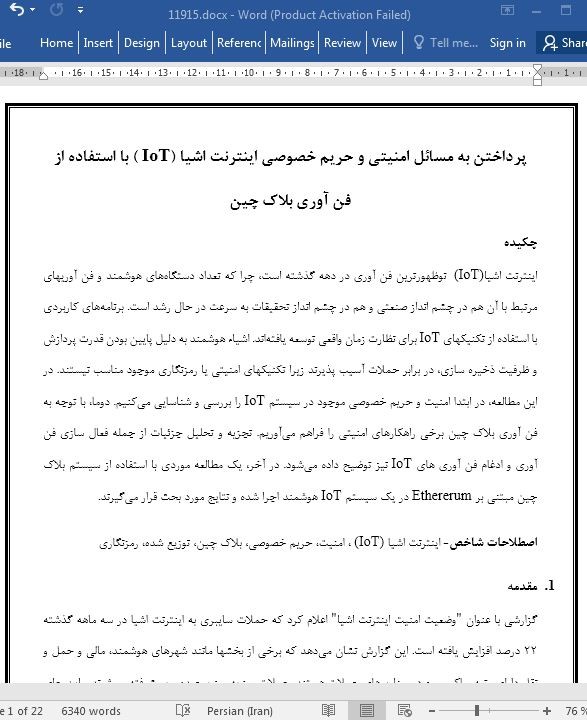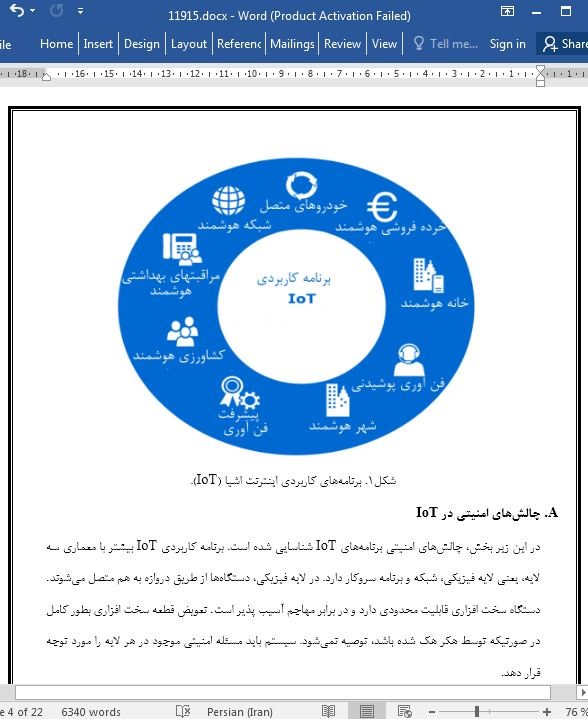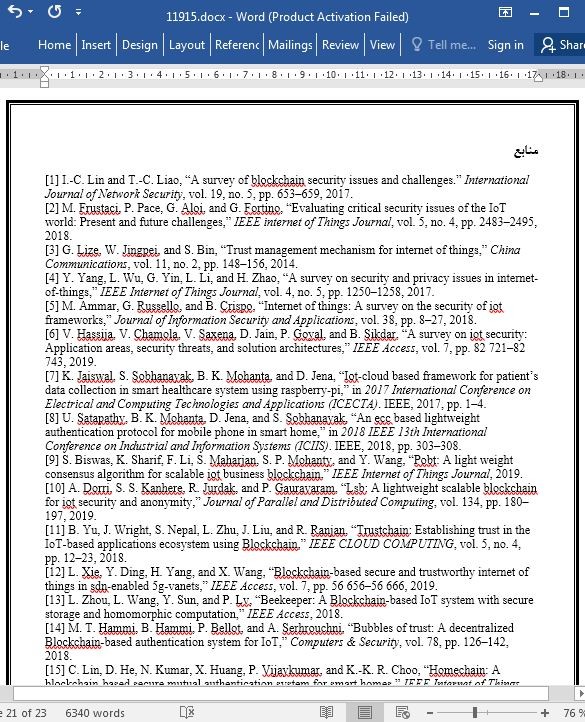
پرداختن به مسائل امنیتی و حریم خصوصی اینترنت اشیا (IoT) با استفاده از فن آوری بلاک چین
چکیده
اینترنت اشیا (IoT) نوظهورترین فن آوری در دهه گذشته است، چرا که تعداد دستگاههای هوشمند و فن آوریهای مرتبط با آن هم در چشم انداز صنعتی و هم در چشم انداز تحقیقات به سرعت در حال رشد است. برنامههای کاربردی با استفاده از تکنیکهای IoT برای نظارت زمان واقعی توسعه یافتهاند. اشیاء هوشمند به دلیل پایین بودن قدرت پردازش و ظرفیت ذخیره سازی، در برابر حملات آسیب پذیرند زیرا تکنیکهای امنیتی یا رمزنگاری موجود مناسب نیستند. در این مطالعه، در ابتدا امنیت و حریم خصوصی موجود در سیستم IoT را بررسی و شناسایی میکنیم. دوما، با توجه به فن آوری بلاک چین برخی راهکارهای امنیتی را فراهم میآوریم. تجزیه و تحلیل جزئیات از جمله فعال سازی فن آوری و ادغام فن آوری های IoT نیز توضیح داده میشود. در آخر، یک مطالعه موردی با استفاده از سیستم بلاک چین مبتنی بر Ethererum در یک سیستم IoT هوشمند اجرا شده و نتایج مورد بحث قرار میگیرند.
1. مقدمه
گزارشی با عنوان "وضعیت امنیت اینترنت اشیا" اعلام کرد که حملات سایبری به اینترنت اشیا در سه ماهه گذشته 22 درصد افزایش یافته است. این گزارش نشان میدهد که برخی از بخشها مانند شهرهای هوشمند، مالی و حمل و نقل دارای رتبه ماکسیموم در سناریوهای حملات هستند. حملات روز به روز پیچیده و پبیشرفته میشوند و این جای نگرانی دارد. در دهه اخیر، فن آوری بلاک چین یکی از مفاهیم نو ظهور در نظر گرفته می شود که هم در تحقیقات و هم صنعت پذیرفته شده است و دارای شش ویژگی اصلی غیر متمرکز، تغییر ناپذیر، شفاف، مستقل، ناشناس و منبع باز میباشد (1). به همین ترتیب، IoT نیز یکی از تکنیکهای امیدوار کننده است که با استفاده از تعداد زیادی از برنامههای هوشمند در حال توسعه میباشد. از حسگرها، دستگاههای هوشمند و عملگرها برای پیاده سازی برنامههای IoT استفاده میشود. در شکل 1، برخی از برنامههای امیدوار کننده مبتنی بر اینترنت اشیاء نشان داده شده است. معماری اصلی سیستم IoT سه لایه است که متشکل از لایه فیزیکی، لایه شبکه و لایه برنامه میباشد. نویسندگان در (2)، مسائل امنیتی موجود در هر یک از لایههای معماری IoT را مورد بحث قرار دادند. در یک برنامه کاربردی IoT ، دستگاههای مختلف ناهمگن متصل شده و با یکدیگر ارتباط برقرار میکنند. از آنجایی که اکثر دستگاههای هوشمند دستگاههای سطح پایین و سادهای هستند، در برابر حملات مختلف آسیب پذیرترند. بنابراین پیاده سازی برنامههای هوشمند مبتنی بر IoT ، به یک الگوریتم سبک برای رمزگذاری/رمزگشایی، ارتباط ایمن و محاسبه نیاز دارد. هدف اصلی امنیتی، یعنی CIA (محرمانگی، یکپارچگی و در دسترس بودن) باید توسط برنامه حفظ شود.
Abstract
Internet of Things (IoT) has been the most emerging technology in the last decade because the number of smart devices and its associated technologies has rapidly grown in both industrial and research prospectives. The applications are developed using IoT techniques for real-time monitoring. Due to low processing power and storage capacity, smart things are vulnerable to the attacks as existing security or cryptography techniques are not suitable. In this study, we initially review and identify the security and privacy issues that exist in the IoT system. Second, as per blockchain technology, we provide some security solutions. The detailed analysis, including enabling technology and integration of IoT technologies, is explained. Finally, a case study is implemented using the Ethererum-based blockchain system in a smart IoT system and the results are discussed.
I. INTRODUCTION
CYBER attacks on Internet of Things has increased by 22% in last quarter asserted a report titled ”State of IoT Security”. The report suggested that some of the sectors like smart cities, financial and transport, have a maximum ranking in attacks scenario. Day by day, attacks are getting sophisticated and high-grade, which is a matter of concern. In the last decade, Blockchain technology is one of the emerging concepts accepted by both research and industry, having six principal characteristics decentralized, immutable, transparent, autonomy, anonymity, and open source[1]. Similarly, IoT is also one of the promising technical filed using lots of smart application are being developed. The sensors, intelligent devices, and actuators are used to implement IoT applications. In Fig. 1, some of the promising IoT based applications are shown. The basic architecture of the IoT system is three layers consists of the physical layer, network layer, and application layer. The authors in [2], discussed security issues present in each of the IoT architecture layer. In an IoT application, different heterogeneous devices are connected and communicated to each other. As most of the smart devices are low-end devices, they are more vulnerable to different attacks. So to implement IoT based smart applications required a lightweight algorithm for encryption/decryption, secure communication, and computation. The basic security goal that is CIA (Confidentiality, Integrity, and Availability) must be maintained by the application.
چکیده
1. مقدمه
2. مسئله امنیت و حریم خصوصی در IOT
A. چالشهای امنیتی در IoT
B. چالشهای حریم خصوصی در IoT
3. کارهای مهم در مورد امنیت و حفظ حریم خصوصی با استفاده از بلاک چین
4. معماری و عملکرد بلاک چین
5. تأثیر بلاک چین برای IoT
A. روش راه حل با استفاده از بلاک چین
B. برنامههای کاربردی IoT ، روش راه حل بلاک چین
6. تنظیمات آزمایشی و تجزیه و تحلیل نتایج
7. نتیجه گیری
منابع
Abstract
I.Introduction
II.Security and Privacy Issues in IoT
A. Security challenges in IoT
B. Privacy Challenges in IoT
III.Critical Work on IoT Security and Privacy Using Blockchain
IV.Architecture and Functionality of Blockchain
V.Impact of Blockchain for IoT
A. Solution Approach using Blockchain
B. IoT Applications a Blockchain Solution Approach
VI.Experimental Setup and Results Analysis
VII.Conclusion
REFERENCES
- اصل مقاله انگلیسی با فرمت ورد (word) با قابلیت ویرایش
- ترجمه فارسی مقاله با فرمت ورد (word) با قابلیت ویرایش، بدون آرم سایت ای ترجمه
- ترجمه فارسی مقاله با فرمت pdf، بدون آرم سایت ای ترجمه



